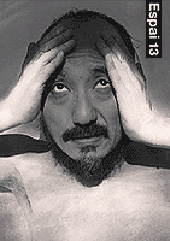- Exhibition program
- Cycle: Obsessions (zero % standard)
- Artist
- Sumi Maro
- Dates
- —
- Curated by
- Montse Badia
Meticulous detail is one of the main features of the work of Sumi Maro (Gifu, Japan, 1954). In his gigantic enterprises he faithfully copies works that are milestones in the collective memory, making subtle additions that bring their points of reference and interpretations up to date. This is the case of The Battle of Issus (1529) by Albrecht Altdorfer (1480-1538), a splendid composition that recreates Alexander the Great's legendary battle at Issus against the Persian king Darius (333 a.d. ). There are many anecdotes concerning this work, one being that it was one of Napoleon's favourite paintings and he had it hanging in his bathroom. At present, it forms part of the collection at the Alte Pinakothek in Munich . Like Altdorfer, Sumi Maro spent more than three years painstakingly reproducing every minute detail of this not very large canvas (158.4 x 120.3 cm) in which – in tribute to its relevance today (and also to collectors of his own works) – he incorporates the images of a collector, the pianist and conductor Christian Zacharias, and of the artist himself, as figures in the battle.
Impressed by this painting from an early age on account of its striking composition and strong colouring, Christian Zacharias was in fact the catalyst for the piece since it was he who suggested this ambitious project to the artist. In Sumi Maro's version, Dedicated to Albrecht Altdorfer Sumi Maro Shifts A. A. Soul from the Battle of Alexander to the Battle of Christian Zacharias , also titled The Battle (1997-1999), Zacharias becomes the face of almost all the people appearing in the battle. But it also represents the artist's own struggle with himself. For the three years this work took, during which he produced a number of collages, studies and preliminary drawings, the painting came to have different meanings for him and, apart from its more technical aspects, acquired increasingly contemporary connotations.
His obsession as a copyist and also as a portraitist defines another facet of Sumi Maro's art. He not only includes people close to him in his copies of historical paintings but he also produces numerous portraits in which the figures are women with whom he has a platonic love affair. Aoki and Fatiah are just two of the names of these muses that appear in successive series of paintings that are true devotional icons and mark different stages in his artistic work.
Aoki, dressed in her school uniform, appears on the quadriga carrying Zacharias in The Battle . This is one of the last appearances of this platonic muse who was a constant presence in many of Sumi Maro's pictures painted over thirteen years. Sometimes he depicts her as the main figure; at other times, her portrait appears in the most unexpected places, such as the image on someone's signet ring, a tattoo on an arm, or a picture within a picture.
The second of Sumi Maro's masterpieces is based on Jan van Eyck's famous Ghent altarpiece (1432). The ten small drawings and collages in the series titled Fatiah – Heiliger Ort in Gent I-X (Fatiah – The holy place in Ghent I-X) (2003) are almost like reliquaries containing details from the painting known as The Mystical Lamb in Ghent cathedral. These collages are another example of the artist's very personal and certainly very radical relationship with the masterpieces of Western painting. He faithfully reproduces some of the details of the picture and sticks them on to envelopes that have been sent to him by post, together with small portraits of his muse Fatiah, who is present throughout the series. All this shows the artist's open-minded attitude to the painting he takes as his starting point.
Finally, the small masterpiece Weg zu Fatiah V (Path to Fatiah) (2001) is a devotional icon and altar – almost a chapel – containing the motif from Leonardo da Vinci's famous picture The Virgin of the Rocks (1483). The scene includes the portrait-apparition of Fatiah that announces, with a certain reference to Pointillism, the introduction of other “contemporary masters” ( Van Gogh, Gauguin, Lichtenstein, Klee, etc.) that the artist explores in other series, always of course with the presence of the muses that imbue his works with real significance – and with life, as he himself has declared.
Sumi Maro approaches the masterpieces of Western painting with total freedom, incorporating in them his own passions and obsessions as well as a certain sense of humour in order to bring them closer to the present day.
Montse Badia
October 2004


